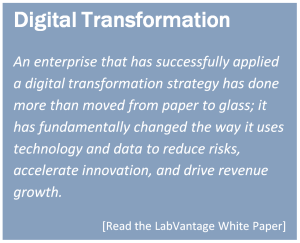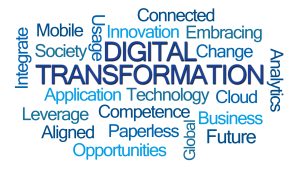 There’s a lot of buzz about digital transformation (DT) happening in the business world, and like it or not DT is coming to your organization. For some, the transformation is already well underway. For others, not so much.
There’s a lot of buzz about digital transformation (DT) happening in the business world, and like it or not DT is coming to your organization. For some, the transformation is already well underway. For others, not so much.
The business world was a paper-based world for a very long time. And while computers and technology have been around for decades, in many ways technology still isn’t being used to full effect.
But we are no longer in ‘early-adopter’ territory when it comes to connecting the disparate pieces of our labs and businesses together. In some industries – bio/pharma, for example – labs are reaching the crisis point, simply because of changing compliance demands and the vastness of data they confront daily. It’s no longer a choice. They must transform to deliver.
IDC reports that spending on digital transformation projects will exceed $2 trillion in 2019, and that 40% of all technology spending will go toward technologies supporting digital transformation projects.
But what, exactly, is digital transformation?
What Does Digital Transformation Mean?
Salesforce defines digital transformation as “the process of using digital technologies to create new — or modify existing — business processes, culture, and customer experiences to meet changing business and market requirements. This reimagining of business in the digital age is digital transformation.”
Marc Benioff, Chairman and co-CEO of Salesforce, noted that “every digital transformation is going to begin and end with the customer, and I can see that in the minds of every CEO I talk to.”
 In our latest whitepaper on Navigating the Digital Transformation Journey, LabVantage CEO John Heiser explains digital transformation is “about the way that enterprises use technology and data to build a business ecosystem, thereby reducing risk, accelerating innovation, and driving growth.”
In our latest whitepaper on Navigating the Digital Transformation Journey, LabVantage CEO John Heiser explains digital transformation is “about the way that enterprises use technology and data to build a business ecosystem, thereby reducing risk, accelerating innovation, and driving growth.”
Objectives of Digital Transformation
A well-executed digital strategy can yield a number of benefits to organizations. Among them:
- Higher throughput
- Lower risk
- Sustained regulatory compliance
- Improved quality
- Measurable operational cost savings
Every single one of these benefits translates into an operational and financial improvement for your lab, and for your business overall.
 Surprising Range of Companies on the DT Journey
Surprising Range of Companies on the DT Journey
When it comes to digital transformation, company size isn’t a very good indicator of progress. There are marquee Fortune 100 companies who have yet to begin – or even consider – it. Other major corporations are just now beginning the migration from paper- and Excel-based lab management. On the other hand, there are small, single-site firms already well down the path towards a purely digital (or ‘glass-based’) existence.
LabVantage has seen this firsthand in our discussions with companies of every size, across many industries. In what has become an increasingly familiar refrain, organizations report being locked into outdated proprietary systems, or ‘stitched-together-over-time’ technology solutions.
They reference legacy platforms which don’t ‘play well with others,’ impeding their ability to build a connected lab or business. Another common challenge: systems are increasingly failing to keep up with evolving regulatory or compliance standards.
A prime topic of discussion in a growing number of companies is migration to the cloud. This has become an especially attractive (and increasingly necessary) move for organizations that have grown beyond just a single lab or a few lab locations.
 Have You Already Taken Your First DT Step?
Have You Already Taken Your First DT Step?
Companies leveraging LIMS have already taken the first step towards DT. Once validated and operational, even an earlier-generation, on-premise LIMS resulted in significant elimination of paper from the lab. Those companies who employ ELNs have done away with physical lab notebooks. Labs with the capability to integrate with other instruments, even if only in some limited capacity, have further reduced their paper load.
In recent years, LIMS’ ability to interface & interact with other lab systems – either via an on-premise install or in the cloud – has improved to the point where data can be centrally managed and leveraged to improve outcomes.
That is at the core of what we do at LabVantage – deliver the most flexible LIMS available, integrate it with other business & scientific platforms, and create a frictionless exchange of data and insights.
The Business Journey of Digital Transformation
Digital transformation is no longer a technology journey. It’s a business journey that uses technology as its vehicle to improve agility and innovation, and drive business growth.
We’ve reached a key inflection point in which companies born today will never know anything but a digital ecosystem. At the same time, existing organizations must evolve to overthrow the legacy of functional silos and redundant processes.
LabVantage helps organizations eliminate the risks and realize the potential of their digital transformation strategies by providing a highly configurable and uniquely cloud-ready LIMS.
For a closer look at how LabVantage has designed our technology to help labs lead successful digital transformation initiatives, read our whitepaper (LIMS and the Digital Ecosystem: Navigating the Digital Transformation Journey).

